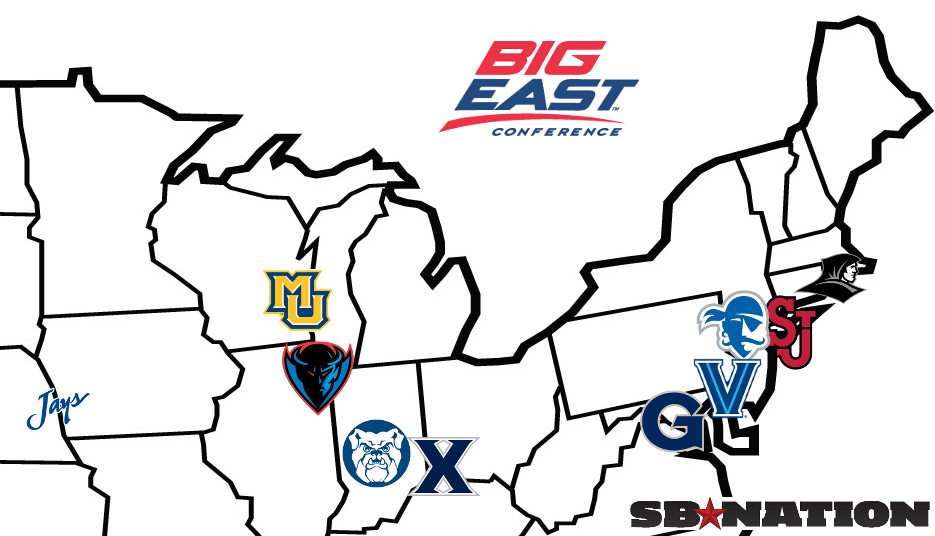I have followed college basketball across the country and have been fortunate to see many games in many different venues. I've had the opportunity to visit with fans from schools across the country.
Two years ago, when Creighton University joined the Big East Conference, we attended the mens basketball tournament as a family. When purchasing the tickets, we were told that the Big East used a "ribbon seating" format in Madison Square Garden. In all of my college basketball travels, I had never heard of "ribbon seating". In fact, a Google search does not reveal any results that are relevant to this definition.
When I inquired with the Creighton ticket office, I was told that rather than seating fans of different schools in a "block", where they all sit together, tickets are distributed in "ribbons" or strips of two to perhaps ten seats in a row. Fans sit with and among those from other Big East schools.
The goal of "ribbon seating" is to not have big blocks of empty seats appearing on television. But the “ribbon seating" is not fooling anyone. Madison Square Garden looks empty on Wednesday night of the tournament because it is empty. The four lowest seeds are playing. There is no seating configuration that will change that.
Treating the fans well and making their experience positive, however, will do more than anything else to resolve the issue of empty seats. There are dozens (hundreds?) of prime seats (lower level at mid-court) that were empty for the first four sessions of the tournament this year. How did "ribbon seating" fix that?
I offer a couple ideas for why the Big East Conference should consider traditional block seating for fans of the Big East tournament:
Secondly, if all fans from each institution sit together, they will not have to be bothered by other fans sitting in front of them who don't care about the game going on and are up and down to the rest rooms or concession areas. There is nothing more annoying when trying to watch my team's game than some fan that disrupts the entire row at the least opportune time because he doesn't care about the current game. I experienced that many times during the two Big East tournaments I have attended.
Finally, it would be nice if the conference did something that is good for the fans in the arena rather than letting television dictate their every decision. I recognize the importance of the television contract. Madison Square Garden is a unique arena in that the lighting contrast between the floor and the seating is dramatic (perhaps the most dramatic of any major venue). It is difficult to see the seats because they appear quite dark on television.
I can attest to the fact that the empty seats from losing teams will find their way into the hands of basketball fans. The experience of wading through oceans of ticket scalpers on the way in to the Garden ensures that. Those blocks of seats will fill in when a school loses. The tickets are expensive. If fans choose to go home after their team loses, they will sell their ticket prior to their departure. But when a team loses, there is a better chance fans will go to remaining tournament games if they can sit in the block of fellow supporters of their school rather than among fans of other schools.
This is not the old Big East where most schools were a short drive away. Five schools, Creighton (1,100 miles), Marquette (900 miles), DePaul (800 miles), Butler (700 miles) and Xavier (600 miles) all required air transportation to get to New York for a weekend tournament. Add the cost of four nights in the hotel and four days of meals in the city and you have a considerable investment by a fan of any of these schools to attend the tournament.
The fans in the arena are customers. Please treat us as such. Make our experience a better one. Let us sit with each other after we make that investment to support the Big East Conference.
C'mon Big East. I urge you to consider changing the seating for future Big East Men's Tournaments to a tradition block configuration. If the only reason you can give for utilizing "ribbon seating' is that "it is the way we've always done it", then it's time to re-think it.
P.S. I received a response to the letter I sent to the Big East commissioner. "The BIG EAST Conference is always searching for ways to improve the fan experience and we are spending the summer working with MSG staff and our institutional ticket and marketing representatives to review our current ticketing practices and methods. We will be certain to incorporate your thoughts into our discussions." It was copied and pasted very neatly into the email.







